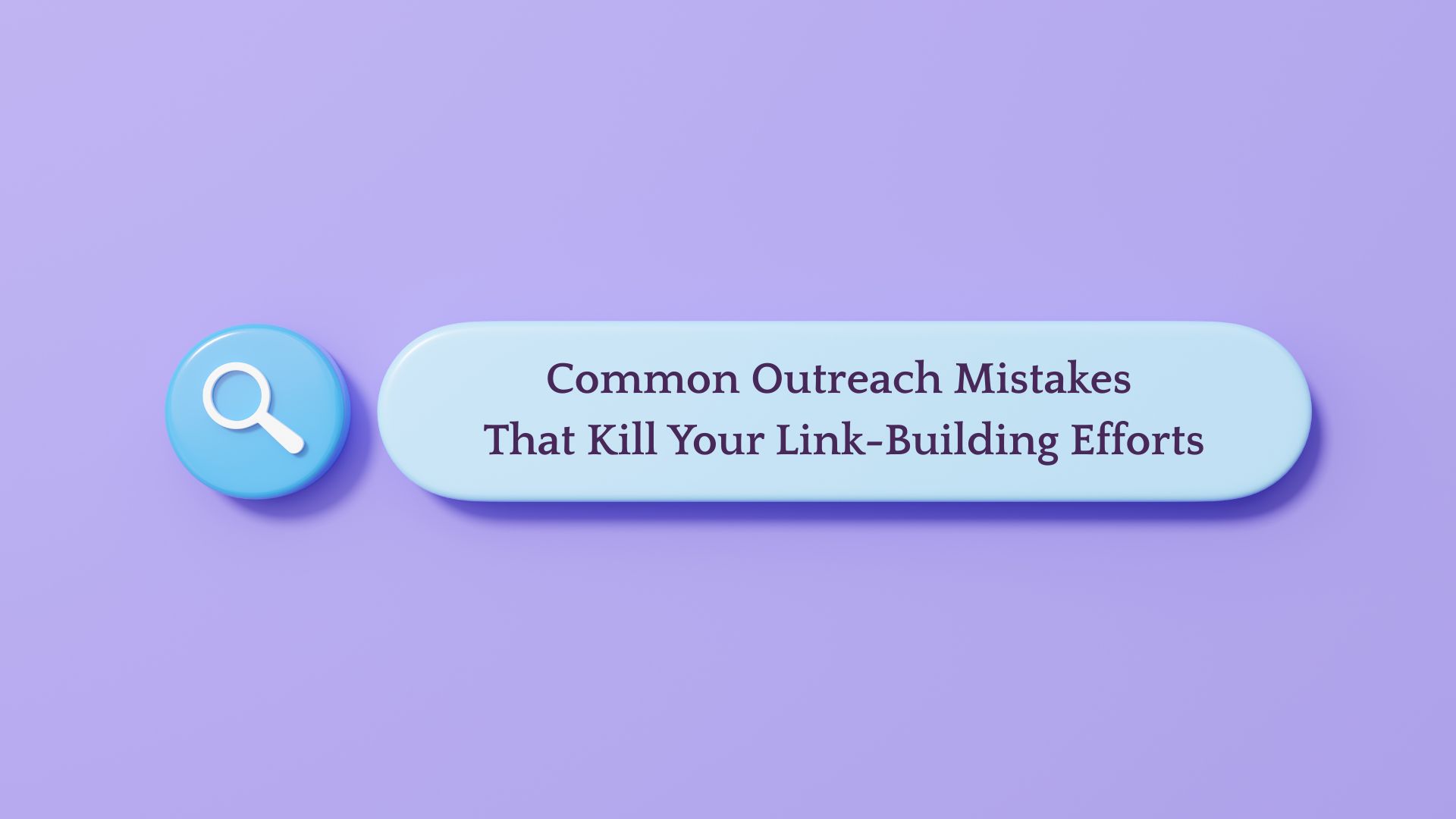Many website owners and marketers struggle with link-building outreach, often overlooking critical aspects that hinder success. Mistakes such as failing to personalize messages, targeting irrelevant or low-quality sites, and neglecting follow-ups can severely limit outreach results. Recognizing and addressing these issues is essential for improving online visibility in today’s SEO landscape.
Effective link-building outreach requires a strategic, data-informed approach. Marketers must understand their audience and tailor communications that resonate with potential link partners. A thoughtful, human-centered outreach strategy enhances engagement and nurtures long-lasting relationships.
By avoiding common pitfalls and adapting strategies accordingly, link builders can improve their outcomes and earn high-quality backlinks that drive organic traffic and improve search rankings.
Why Link Building Outreach Still Matters in 2025
Despite algorithm updates and evolving search behaviors, link building remains a cornerstone of SEO. This section explores why outreach remains vital for visibility and authority.
The Ongoing Importance of Backlinks
Despite changes in Google’s algorithm, backlinks remain among the strongest ranking factors. High-quality, relevant backlinks indicate that a site is trustworthy, authoritative, and valuable to users. Outreach helps secure those links from trusted sources.
Outreach as a Relationship-Building Tool
Modern link-building isn’t just about getting links — it’s about building real relationships in your niche. A personalized outreach strategy can lead to more than links: guest post opportunities, co-marketing initiatives, podcast invites, and long-term collaboration.
Most Frequent Outreach Mistakes to Avoid
Many outreach campaigns fall short due to avoidable missteps. This section covers the most common mistakes that sabotage link-building success.
1. Sending Generic Outreach Emails
One of the most common and fatal errors is sending templated, generic emails that fail to engage recipients. Inboxes are flooded with cold emails — personalization is the only way to stand out.
Fix: Personalize subject lines and opening lines, reference the recipient’s content, and offer genuine value.
2. Failing to Follow Up
A surprising number of outreach campaigns stop after a single email. But let’s be real—people are busy. Emails get buried, ignored, or forgotten. Assuming silence means rejection is a big mistake.
Fix: Send 1–3 follow-up emails spaced over 7–10 days, each adding new value or context.
3. Ignoring Relevance and Site Quality
Not all backlinks are created equal. Reaching out to irrelevant, spammy, or low-quality websites can dilute your backlink profile and even trigger penalties from search engines. Some outreachers get so caught up in chasing quantity that they forget the importance of fit.
Fix: Only contact sites with relevant content, strong editorial standards, and genuine audiences.
4. Prioritizing Quantity Over Quality
Sending hundreds of emails to low-fit prospects might look productive on paper, but it rarely yields real results. Link building isn’t a numbers game—it’s a relationship game.
Fix: Use tools like Ahrefs or Pitchbox to curate targeted, high-quality prospect lists.
5. Focusing Too Much on Your Own Needs
Outreach emails that center entirely on what you want are easy to dismiss. Pitches that start with “Can you link to my article?” without explaining why it’s valuable to the recipient usually go straight to the trash.
Fix: Focus your pitch on how the recipient will benefit — better content, improved UX, or an SEO boost.
6. Not Using AI or Automation Wisely
AI can be a powerful tool to speed up outreach, but misuse it, and you risk sounding like a robot. Fully automated messages that lack nuance, context, and the like are a fast track to being ignored.
Fix: Use AI for prospecting and personalization suggestions, but ensure final messages feel human and sincere.
7. Poor Timing and Frequency
Timing matters. Emails sent at odd hours, during holidays, or all at once in a massive blast can easily get overlooked—or trigger spam filters.
Fix: Use analytics or tools like Instantly.ai to optimize sending times and drip campaigns.
8. Not Vetting Link Opportunities
Not all link opportunities are worth the effort. Accepting every guest post invite or link exchange can clutter your backlink profile with toxic links that hurt more than help.
Fix: Evaluate backlink profiles, spam scores, and traffic data before pursuing link partnerships.
9. Using Overly Aggressive Language or Pressure Tactics
Some outreach emails veer into manipulation—using guilt trips, ultimatums, or urgent language like “This is your last chance!” It’s a surefire way to alienate your prospects.
Fix: Maintain a professional and friendly tone. Make the ask clear, but never aggressive.
10. Forgetting to Include Key Information
Sometimes, the issue isn’t what you say—it’s what you forget to say. Outreach emails that are too vague or missing critical context leave recipients confused and disinterested.
Fix: Include relevant links, who you are, why you’re reaching out, and exactly what you’re asking for.
11. Relying Too Heavily on One Outreach Channel
Email is powerful—but it’s not the only way to reach people. Some prospects are more responsive on LinkedIn, Twitter, or even in niche Slack or Discord communities.
Fix: Diversify your outreach approach. For high-value prospects, consider combining channels. Multichannel outreach feels more authentic and often leads to stronger relationships over time.
Understanding the Consequences of Bad Outreach
Failed outreach doesn’t just stall your campaign — it can harm your reputation and SEO efforts. Let’s explore the potential downsides.
Time and Resource Waste
Sending mass emails without returns drains team bandwidth, software budgets, and valuable time that could’ve been spent on higher-impact efforts. Poor targeting leads to minimal ROI.
Damaged Industry Reputation
Low-effort outreach can alienate peers in your niche, making future collaboration harder. Once your domain or name gets associated with spammy behavior, rebuilding trust becomes challenging.
SEO and Link Profile Risks
Acquiring links from poor sources or via manipulative tactics may lead to penalties or devaluation in rankings. Google’s algorithms quickly spot unnatural link patterns, putting your entire domain’s authority at risk.
How to Craft High-Performing Outreach Emails
Effective outreach starts with a strong email — one that quickly communicates value and makes it easy for the recipient to say yes. Here’s how to get better responses with less guesswork:
Write Value-Driven Subject Lines
Skip vague or salesy headlines. Use relevance or curiosity to earn the open. Example: “Quick idea to improve your [Topic] guide” or “Mentioned you in a post — quick note.”
Get to the Point Quickly
Avoid long intros or unnecessary backstory. Use the first sentence to explain why you’re reaching out and why it matters. Break up text for easy scanning.
Include a Clear, Specific CTA
Tell them exactly what you’re asking — whether it’s a link, quote, guest post, or feedback — and what they’d get in return. Avoid open-ended asks.
Personalize with Context or Social Proof
Reference a recent post, podcast, or shared connection. Briefly show that you’ve done your homework and aren’t just blasting a list. A touch of familiarity builds instant trust.
Personalization: The Key to Outreach Success
Personalization is the difference between a cold email and a warm reply. This section explains how to do it right.
Why Personalization Works
Customizing your message shows effort, intent, and respect for the recipient’s time. It boosts open and reply rates significantly.
What to Personalize
- Their name (correctly spelled)
- A reference to their content or recent project
- A shared interest, niche, or connection
Tools to Scale Personalization
Tools like Respona, Mailshake, and Instantly.ai support dynamic personalization fields, allowing you to scale outreach without sacrificing quality.
Timing, Frequency, and Follow-Ups: Best Practices
When and how often you reach out matters as much as what you say. Use these timing tactics to improve your chances.
Best Days and Times to Send
Studies show Tuesday through Thursday mornings often yield the highest response rates. Test and refine timing using your outreach tool’s analytics.
The Follow-Up Formula
Wait 3–5 business days after the initial email. Send a friendly follow-up, referencing the original message and offering something new, like a different content angle or resource.
Know When to Stop
Two or three follow-ups are enough. If there’s no response, move on without burning the bridge.
Outreach Metrics That Actually Matter
Tracking the right metrics helps you identify what’s working and what needs improvement. Focus on these performance indicators:
- Open Rate: Are your subject lines getting attention?
- Reply Rate: How often are people responding?
- Positive Response Rate: Are you earning links or partnerships?
- Time to Response: How quickly do replies come in?
- Conversion Rate: How many emails lead to actual backlinks?
Use these insights to test subject lines, tweak message structure, refine your CTAs, and improve follow-up timing. Let performance data shape your strategy.
Adapting Outreach Based on Performance
Outreach isn’t one-size-fits-all. Use feedback and metrics to evolve your process and improve future campaigns.
Use metrics and feedback loops to improve:
- Target smarter: Trim your outreach list only to include relevant, high-authority sites.
- Improve templates: Refine email scripts based on what works.
- Scale wisely: Use automation where it saves time, but don’t sacrifice authenticity.
- Document processes: Create SOPs so your outreach team stays aligned and scalable.
Conclusion
Effective link-building outreach isn’t just about earning backlinks — it’s about building real, human relationships that create long-term value. The most successful campaigns come from a mindset of service, not self-interest.
By focusing on relevance, authenticity, and mutual benefit, you position yourself as a trusted partner, not just another cold email. Avoid the common pitfalls, stay consistent with testing and optimization, and always lead with value.
In the end, the best links come from trust, and trust is built through genuine connection.




